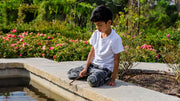
Saturday morning. The sun is just warming your garden, and instead of screens or cereal bowls, your kids are leaning over a pond, eyes wide as a damselfly dries its new wings. Moments later, a frog pops up, setting off delighted squeals and twenty new questions. Few backyard projects create this blend of wonder and discovery as reliably—or as effortlessly—as a well-planned pond. With today’s quiet, solar-powered equipment from Poposoap, that wonder comes without extension-cord hazards or big utility bills, making the feature as practical for parents as it is magical for children.
Why Backyard Ponds Are Magical for Children
Children learn best when all five senses fire at once. A living pond offers moving water to watch, stones to stack, lilies to smell, even textures of smooth frog eggs to (gently) touch. It is play disguised as STEM, a storybook scene happening in real time. The ever-changing cast—dragonflies one week, baby fish the next—keeps kids returning outside long after a swing set would have lost its novelty.
Just as important, a pond teaches stewardship. When a child skims leaves from the surface or tests pH with a dip strip, they grasp that healthy environments need caretakers. That mindset lasts a lifetime and feels more like adventure than chore.
A Safe and Engaging Outdoor Playground

Safety first, exploration second. Designing a kid-friendly pond starts with shallow shelves—think 6- to 12-inch beach entries—where toddlers can wade without risk. Curved edges and rounded boulders prevent scrapes, and dense plantings soften any accidental bump.
Because Poposoap’s pumps and filters run on low-voltage DC from rooftop or remote solar panels, you eliminate the chief electrical hazard in water play: grid power. Parents can relax while kids race floating leaf “boats” past the gentle ripple of a Poposoap Solar Fountain Pump humming invisibly beneath the surface. No cords to trip over, no outlets to guard with covers.
Add a few large stepping stones across the narrow end and you’ve built a natural balance-beam that encourages gross-motor skills while letting children peer into the clear shallows at eye level. The pond becomes obstacle course, splash pad, and fairy-tale stage in one.
An Outdoor Science Lab: Learning Through Observation

Science isn’t memorizing facts; it’s noticing patterns and asking why. A backyard pond delivers endless natural experiments:
- Life cycles in real time — Watch tadpoles sprout legs, dragonfly nymphs crawl up reeds, and water lilies open with the morning sun.
- Water chemistry — Use simple test kits to track pH and ammonia. Kids connect abstract numbers to visible health: crystal water versus algae bloom.
- Food webs — Introduce mosquito-eating minnows and observe how predator–prey relationships work, then discuss why overfeeding fish upsets that balance.
- Physics of water — Tiny waterfalls powered by a Poposoap Pond Waterfall Kit let children explore gravity, flow rate, and sound engineering.
Because everything happens in steps—egg, larva, adult; cloudy, clearer, sparkling—children see cause and effect unfold far better than in a textbook diagram.
Tools & Setup Tips for Kid-Friendly Ponds

(Use Poposoap solar pumps for quiet, cord-free water movement)
Choose a compact solar pump. The Poposoap 10-Watt Solar Fountain Pump circulates up to 120 gallons per hour—ideal for ponds under 300 gallons. Its brushless motor is nearly silent, so children can hear frogs and birds instead of machinery.
Add all-in-one filtration. A Poposoap Solar Pond Filter tucks pump, coarse foam pads, and bio-balls into one low-profile box. Snap it in at the deep end and let biology handle the cleanup while kids focus on spotting snails.
Illuminate responsibly. Nighttime pond gazing doubles the fun, but high-voltage spotlights ruin the firefly show. Poposoap RGB Multi-Color Solar Pond Lights stake around the rim, switching on automatically at dusk. Set them to soft warm white during story hour, then let them fade so nocturnal wildlife feels welcome.
Create micro-habitats. Layer pea gravel for minnow nesting, stack flat shale ledges for frog perches, and anchor a floating planter so roots dangle where kids can watch fish weave through. A Poposoap Floating Pond Fountain aerates deeper volumes without stealing surface space from water lilies.
Keep everything reachable. Situate solar panels on a south-facing fence or removable stake; kids love “checking the solar energy” and brushing dust off. Maintenance becomes another teachable moment, not an adults-only chore.
Ideas for Pond-Themed Educational Activities

-
Insect Safari Journals
Hand out small notebooks and colored pencils. Each child sketches or lists every winged visitor in a 15-minute window. Later, match drawings to field-guide photos and discuss pollination.
-
DIY Water-Tester Lab
Mix baking soda and vinegar to create high and low pH samples, then let kids compare pond water with test strips. They predict which fish or plants might struggle at each extreme.
-
Sound Mapping
Sit quietly for five minutes and write down every noise: bubbling fountain, robin call, wind in cattails. Children learn that healthy ecosystems speak in multisensory ways.
-
Leaf Boat Regatta
Kids build tiny rafts from leaves and twigs. Adjust fountain nozzles on the Poposoap pump to create racing lanes of different flow speeds, then talk about current and drag.
-
Photo Time-Lapse
Mount an old phone on a tripod aimed at the pond. Capture one shot every day for a season; kids stitch the pictures together and watch plants grow and water levels rise or fall, linking weather patterns to pond dynamics.
Each activity layers observation with creativity, planting seeds for future naturalists or engineers.
Benefits Beyond Biology

Mindfulness & Mental Health
The white-noise hush of a fountain reduces stress—documented by studies showing lower cortisol after ten minutes near moving water. Children who decompress outdoors often sleep better and handle classroom challenges with more resilience.
Social Bonding
Netting debris, feeding fish, or adjusting solar panels turns into family teamwork. Grandparents share gardening wisdom; older siblings teach younger ones safe frog handling. The pond becomes a shared project that ages with the children.
Environmental Stewardship
When kids see how a discarded snack wrapper blows into the water and clouds it overnight, littering stats become personal. Composting fallen leaves for the pond garden completes a nutrient loop they can hold in their hands.
Creativity & Storytelling
Dragonflies become dragons, lily pads fairies’ stepping stones. Many reluctant writers will fill pages describing their backyard “kingdom” when the scenery is literally alive outside the window.
Conclusion: Where Nature Meets Imagination
A backyard pond is equal parts playset and laboratory—an invitation for children to poke, scoop, measure, and marvel. Build it with gentle slopes, solar-powered Poposoap pumps, and plant-filled shallows, and it stays as safe as it is inspiring.
Most of all, a kid-friendly pond grows with its caretakers. Toddlers start with leaf races; teenagers might capture microscope footage of pond plankton for a science fair. Throughout, the soft gurgle of a solar fountain reminds everyone that nature thrives on balance and gentle stewardship.
Install the water, open the gate, and watch curiosity ripple outward—proof that the best classrooms often have no walls at all.







